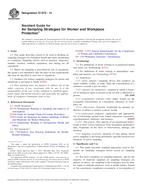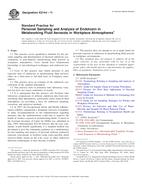Potřebujeme váš souhlas k využití jednotlivých dat, aby se vám mimo jiné mohly ukazovat informace týkající se vašich zájmů. Souhlas udělíte kliknutím na tlačítko „OK“.
ASTM D7200-12
Standard Practice for Sampling and Counting Airborne Fibers, Including Asbestos Fibers, in Mines and Quarries, by Phase Contrast Microscopy and Transmission Electron Microscopy (Withdrawn 2021)
Automaticky přeložený název:
Standardní praxe pro odběr vzorků a počítání vláken v ovzduší, včetně azbestových vláken, v dolech a lomech, fázovým kontrastem mikroskopie a transmisní elektronové mikroskopie
NORMA vydána dne 15.10.2012
Informace o normě:
Označení normy: ASTM D7200-12
Poznámka: NEPLATNÁ
Datum vydání normy: 15.10.2012
Kód zboží: NS-37844
Počet stran: 25
Přibližná hmotnost: 75 g (0.17 liber)
Země: Americká technická norma
Kategorie: Technické normy ASTM
Kategorie - podobné normy:
Anotace textu normy ASTM D7200-12 :
Keywords:
air monitoring, asbestos, fibers, membrane filter method, mines and quarries, phase contrast microscopy, sampling and analysis, ICS Number Code 13.040.30 (Workplace atmospheres)
Doplňující informace
| Significance and Use | ||||||||||||||||||||||||||
|
5.1 Users of this practice must determine for themselves whether the practices described meet the requirements of local or national authorities regulating asbestos or other fibrous hazards. 5.2 Variations of this practice have been described by the Asbestos Research Council in Great Britain (5.3 Advantages 5.3.1 The technique is specific for fibers. PCM is a fiber counting technique that excludes non-fibrous particles from the analysis. 5.3.2 The technique is inexpensive, but requires specialized knowledge to carry out the analysis for total fiber counts, at least in so far as the analyst is often required under regulations to have taken a specific training course (for example, NIOSH 582, or equivalent). 5.3.3 The analysis is quick and can be performed on-site for rapid determination of the concentrations of airborne fibers. 5.3.4 The procedure provides for a discriminate counting technique that can be used to estimate the percentage of counted fibers that may be asbestos. 5.4 Limitations 5.4.1 The main limitation of PCM is that fibers are not identified. All fibers within the specified dimensional range are counted. Differential fiber counting may sometimes be used to discriminate between asbestos fibers and fibers of obviously different morphology, such as cellulose and glass fiber. In most situations, differential fiber counting cannot be used to adequately differentiate asbestos from non-asbestos fibers for purposes of compliance with regulations without additional positive identification. If positive identification of asbestos is required, this must be performed by polarized light or electron microscopy techniques, using a different portion of the filter. 5.4.2 A further limitation is that the smallest fibers visible by PCM are about 0.2 µm in diameter, while the finest asbestos fibers may be as small as 0.02 µm in diameter. 5.4.3 Where calculation of fiber concentration provides a result exceeding the regulatory standard, non-compliance is assumed unless it can be proven that the fibers counted do not belong to a member or members of the group of fibers regulated by that standard. |
||||||||||||||||||||||||||
| 1. Scope | ||||||||||||||||||||||||||
|
1.1 This practice2 describes the determination of the concentration of fibers, expressed as the number of such fibers per millilitre of air, using phase contrast microscopy and optionally transmission electron microscopy to evaluate particulate material collected on a membrane filter in the breathing zone of an individual or by area sampling in a specific location. This practice is based on the core procedures provided in the International Organization for Standardization (ISO) Standard ISO 8672(1.2 The practice is used for routine determination of an index of occupational exposure to airborne fibers in mines, quarries, or other locations where ore may be processed or handled. The method gives an index of airborne fiber concentration. The method provides an estimate of the fraction of counted fibers that may be asbestos. This practice should be used in conjunction with electron microscopy (See Appendix X1) for assistance in identification of fibers. 1.3 This practice specifies the equipment and procedures for sampling the atmosphere in the breathing zone of an individual and for determining the number of fibers accumulated on a filter membrane during the course of an appropriately-selected sampling period. The method may also be used to sample the atmosphere in a specific location in a mine or in a room of a building (area sampling). 1.4 The ideal working range of this practice extends from 100 fibers/mm2 to 1300 fibers/mm2 of filter area. For a 1000-L air sample, this corresponds to a concentration range from approximately 0.04 to 0.5 fiber/mL (or fiber/cm3). Lower and higher ranges of fiber concentration can be measured by reducing or increasing the volume of air collected. However, when this practice is applied to personal sampling in mines and quarries, the level of total suspended particulate may impose an upper limit to the volume of air that can be sampled if the filters produced are to be of appropriate particulate loading for fiber counting. 1.5 Users should determine their own limit of detection using the procedure in Practice D6620. For reference, the NIOSH 7400 method gives the limit of detection as 7 fibers/mm2 of filter area. For a 1000-L air sample, this corresponds to a limit of detection of 0.0027 fiber/mL (or fiber/cm3). For OSHA ID 160 the limit of detection is given as 5.5 fibers/mm2 of filter area. For a 1000-L air sample, this corresponds to a limit of detection of 0.0022 fiber/mL (or fiber/cm3). 1.6 If this practice yields a fiber concentration that does not exceed one-half the permissible exposure limit or threshold limit value for the particular regulated fiber variety, no further action may be necessary. If the fiber concentration exceeds one-half of the regulated permissible exposure limit or threshold limit value for the particular regulated fiber variety, it is necessary to examine the data to determine if more than 50 % of the counted fibers are thinner than 1.0 μm, or thicker but with an appearance of asbestos (curvature, splayed ends, or the appearance of a bundle). 1.7 The mounting medium used in this practice has a refractive index of approximately 1.45. Fibers with refractive indices in the range of 1.4 to 1.5 will exhibit reduced contrast, and may be difficult to detect. 1.8 Fibers less than approximately 0.2 µm in diameter may not be detected by this practice. (1.9 This standard may involve hazardous materials, operations, and equipment. This standard does not purport to address all of the safety problems associated with its use. It is the responsibility of the user of this standard to establish appropriate safety and health practices and determine the applicability of regulatory limitations prior to use. For specific precautionary statements, see Section 7. |
||||||||||||||||||||||||||
| 2. Referenced Documents | ||||||||||||||||||||||||||
|
Podobné normy:
Historická
1.4.2014
Historická
1.12.2011
Historická
1.5.2009
Historická
1.10.2012
Historická
1.4.2009
Historická
1.4.2012
Doporučujeme:
Aktualizace technických norem
Chcete mít jistotu, že používáte pouze platné technické normy?
Nabízíme Vám řešení, které Vám zajistí měsíční přehled o aktuálnosti norem, které používáte.
Chcete vědět více informací? Podívejte se na tuto stránku.



 ASTM E1370-14
ASTM E1370-14 ASTM E2144-11
ASTM E2144-11 ASTM E2625-09
ASTM E2625-09 ASTM E2889-12
ASTM E2889-12 ASTM F25/F25M-09..
ASTM F25/F25M-09.. ASTM F50-12
ASTM F50-12
 Cookies
Cookies
